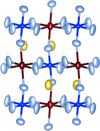issue contents
May 2023 issue

editorial
introduction
scientific commentaries
research papers


An analysis of the effect on diffraction quality that arises from milling crystals of lysozyme with argon and xenon plasma focused ion beams is presented. This is compared with crystals milled using a gallium source. Upper and lower bounds for the thickness of the milling damage layer are estimated.
Fast extraction of three-dimensional nanofiber orientation from WAXD patterns using machine learning


Racemic metallosupramolecular cages were fabricated from homochiral Ni(II)-based triple-stranded helicate building blocks. In hierarchical crystal packing, methyl groups of a cage can be accommodated in cone-shaped metal cluster metallocavitands of adjacent cages in the form of host–guest interactions.


Synthesis and property evaluation of ionic cocrystals and salts of the weakly acidic nutraceutical compound hesperetin support the reliability of crystal engineering approaches based on the PhOH⋯PhO− supramolecular heterosynthon and the effectiveness of cocrystallization in tackling low aqueous solubility of a weakly ionisable compound.




 journal menu
journal menu




 access
access




























